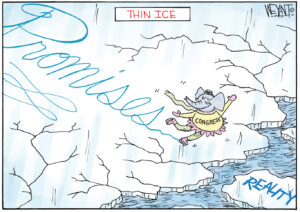Ruling on Nonvoters in Ohio May Embolden Other States
The Supreme Court's recent decision on the state's so-called “Supplemental Process” law could lead others to take steps to disenfranchise minorities, the poor and people with disabilities, who tend to vote Democratic. Flickr
Flickr
In a 5-4 decision released June 11, the U.S. Supreme Court upheld an Ohio law that provides for the removal of infrequent voters from the state’s election rolls.
On the surface, the court’s majority opinion in Husted v. A. Phillip Randolph Institute is a highly technical analysis of whether Ohio’s so-called “Supplemental Process” law runs afoul of the federal National Voter Registration Act of 1993 and the Help America Vote Act of 2002. The court’s decision, written by Justice Samuel Alito and joined by the court’s other Republican appointees, concluded that it did not.
According to Alito, the Ohio law, which dates back to 1994 but in recent years has been more strictly enforced, is simply meant to keep “the State’s voting lists up to date by removing the names of those who have moved out of the district where they are registered.”
Here’s how the “Supplemental Process” works: Voters who have failed to cast a ballot for two consecutive years (the equivalent of one federal election cycle) are mailed a pre-addressed, postage prepaid card asking them to verify that they still reside at the same address. Those who do not return the card and fail to vote in any election for four more years are presumed to have moved and are removed from the rolls.
As Alito and the court’s Republican majority view voting rights, there is no textual inconsistency between the Ohio law and the right to vote, as protected by various federal statutes and the Constitution. All that a resident need do to avoid disenfranchisement is return the postcard sent by the state or vote within an overall six-year period.
Alito’s reasoning seems at first clear enough, and on its face apolitical. Justice Stephen Breyer’s dissenting opinion, joined by the court’s four Democratic appointees, is based largely on differing statutory interpretations.
But, as Justice Sonia Sotomayor pointed out in a separate dissent, Alito’s majority opinion is in reality an exercise of disenfranchisement that “entirely ignores the history of voter suppression” in America and will disproportionately affect minority, homeless, low-income, and disabled voters—who, not coincidentally, tend to vote Democratic.
“Our democracy rests on the ability of all individuals, regardless of race, income, or status, to exercise their right to vote,” Sotomayor wrote, stressing that while most states have a variety of processes in place to maintain the accuracy of their voting lists, only Ohio presently triggers voting-roll purges based solely on an individual’s failure to vote in a single election cycle.
As one instance of the Supplemental Process’ racially disproportionate impact, Sotomayor cited figures compiled by the NAACP for Ohio’s Hamilton County. These showed that African American-majority neighborhoods in downtown Cincinnati have seen 10 percent of their voters removed due to inactivity since 2012, as compared to only 4 percent of voters in an adjacent suburban, majority-white neighborhood.
The Supreme Court’s ruling in Husted upholding the Supplemental Process isn’t just bad news for voters in the Buckeye State. It’s bad news for the nation as a whole, as other Republican-dominated states can be expected to enact similar measures.
The full reach of such measures could be truly staggering. As the League of Women Voters and the New York-based Brennan Center for Justice noted in an amicus (“friend of the court”) brief jointly filed in Husted, there are tens of millions of registered voters nationally who do not regularly vote.
In 2016, the brief notes, the U.S. Election Assistance Commission counted almost 74 million registered voters across the country (37.02 percent of those eligible) who did not cast a ballot in the general election. The vast majority failed to turn up at the polls either because they were turned off by the two major party candidates or for other reasons like transportation problems, illness, disability, or inconvenient polling locations. At most, said the brief, drawing from Census Bureau data, 4.4 percent failed to vote because they had moved from their districts.
But under Alito’s majority opinion, each and every one of the 74 million could be sent a postcard that may or may not be successfully delivered by the post office, resulting in their deregistration for future elections.
“The right to vote is not ‘use it or lose it,’ ” said League President Chris Carson in response to the Husted ruling. “This decision will fuel the fire of voter suppressors across the country who want to make sure their chosen candidates win reelection—no matter what the voters say.”
Notwithstanding the landmark advances achieved in the immediate aftermath of the Civil War with the 14th and 15th Amendments, the adoption in 1920 of the 19th Amendment affording women the right to vote in federal elections, and the passage of the Voting Rights Act in 1965, voter suppression has been the norm for much of our nation’s history. This dates back to the original disenfranchisement of black slaves and women and to the early exclusions of white men without property.
More recently, suppression techniques including voter ID laws and restrictions on early voting and same-day registration have proliferated in many states. And the Supreme Court has made challenging voter suppression more difficult with its 2013 Shelby County v. Holder decision, which dramatically weakened the Voting Rights Act.
Today’s suppression methods may be less obvious than the poll taxes, whites-only primaries and literacy tests of yesteryear, but they are driven by the same purpose of undermining genuine majority rule and deflecting potential threats to the established order.
Current suppression schemes are especially dangerous due to a series of Supreme Court decisions (Citizens United and its progeny) that have unleashed the power of corporations and the wealthy to spend unlimited money on elections. Other recent decisions restrict the right of public-sector unions—an important source of funding for liberal causes and candidates—to collect “fair-share” fees from non-union members that are used to support collective bargaining, and which help to free up other union funds for political expenditures.
By the conclusion of its current term at the end of this month, the court may well outlaw fair-share fees altogether when it decides Janus v. American Federation of State, County, and Municipal Employees, Council 31.
Viewed in context and in conjunction with these developments, the Husteddecision bodes ill for the future of American election law. Above all, it demonstrates that, far from abating, voter suppression is alive and well at the nation’s highest judicial body.
Your support is crucial...As we navigate an uncertain 2025, with a new administration questioning press freedoms, the risks are clear: our ability to report freely is under threat.
Your tax-deductible donation enables us to dig deeper, delivering fearless investigative reporting and analysis that exposes the reality beneath the headlines — without compromise.
Now is the time to take action. Stand with our courageous journalists. Donate today to protect a free press, uphold democracy and uncover the stories that need to be told.






You need to be a supporter to comment.
There are currently no responses to this article.
Be the first to respond.